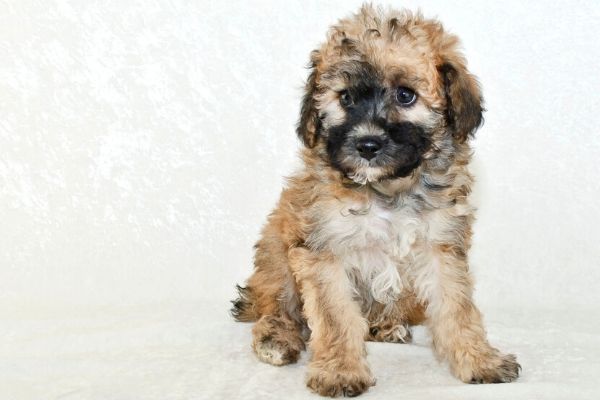When it comes to investing in a puppy, no one likes being taken advantage of, paying far more than they should, or being pressured to buy quickly.
On the flip side, purchasing a puppy for a “steal,” only to later find yourself already attached to a dog with way more health and/or behavioral problems than you bargained for isn’t much fun either.
Realistically, what can you expect to pay for a well-bred, healthy Maltipoo from a reputable breeder?
How Much Does a Maltipoo Cost? Maltipoo prices can range from $500 to more than $2,500 though a price tag between $800 – $1,000 is common. Factors such as a breeder’s reputation and location; a puppy’s age, size, and pedigree; and the current demand can all influence the price.
In the following, we’ll help you understand the price variations for Maltipoos, teach you what to look for in a quality breeder, tell you how to spot an inferior breeder, and provide some tips on locating older Maltipoos who are in need of a new home.
Actual Maltipoo Prices From Real Breeders
To give you a realistic idea of real-world prices, take a look at these actual Maltipoo breeders and the prices they charge for their puppies.
| Breeder | Location | Price |
| Pierce’s Precious Puppies | Illinois | $1,800 |
| Playful Pups For You | Georgia | $650 – $850 |
| Denning Farms | Iowa | $950 – $1,100 |
| Judy’s Pups | California | $875 |
| Artistry Pups | Florida | $2,000 – $2,500 |
Note: Some breeders, such as Pierce’s Precious Puppies and Playful Pups For You, will ship a puppy upon request. You are responsible for all associated costs.
Other breeders refuse to ship to spare the puppies undue stress. Inquire upfront before you fall in love with a particular puppy.
Here’s our complete list of Maltipoo breeders across the US, including those who ship puppies.
10 Factors That Affect the Price of Maltipoos
Is there any rhyme or reason to the wide range of Maltipoo prices? Well, sometimes yes, and sometimes no.
Here are the most common factors that influence a puppy’s price tag, but bear in mind that some breeders, particularly disreputable ones, won’t hesitate to charge exorbitant prices for average pups.
1. Breeder Reputation
Experienced Maltipoo breeders who strive to consistently produce the highest quality, healthiest puppies and who are dedicated to establishing breed standards with the hopes of one day seeing official recognition for the breed by the American Kennel Club (AKC) and other similar organizations usually charge more for their puppies.
2. Age of the Puppy
Most potential puppy owners are looking to buy puppies as soon as they become available for sale so that they won’t miss out on the important socialization window.
The older a puppy grows, the less people tend to be interested, so the price is often reduced, sometimes dramatically.
3. Breed’s Current Popularity
If a breed, or in this case, a crossbreed, is experiencing a sudden surge in popularity, prices often soar as well. When interest wanes, prices usually drop.
4. Registration
A puppy’s price can be affected if the parents or the litter are registered with groups like the AKC.
Wait. A registered mixed dog?
Yes. Crossbreeds can now be registered, receive an ID number, and participate in various dog sport competitions such as obedience and agility trials.
5. Genetic Tests and Health Screenings
Quality breeders will test the parent dogs before breeding to rule out the possibility of inherited health conditions being passed on to the litter.
Numerous veterinary visits are standard after breeding as well to make sure that the pregnancy is proceeding normally and the resulting litter is healthy and thriving.
The associated costs quickly add up and lead to more expensive puppies.
6. Coat Type and/or Color
Some breeders will charge more for a puppy with a certain hair type or color that happens to be in high demand.
7. Size
Puppies who are expected to be quite small when fully grown (less than 5 pounds) usually cost quite a bit more than puppies who are predicted to fall within the normal range for Maltipoos (average 7 -14 pounds).
Unfortunately, not all breeders are honest, and some may try to convince you that although the puppy’s bloodline contains several Miniature Poodles, the pup should remain on the small side.
Don’t be fooled!
Knowing what sizes to expect based on the parentage of the puppy can help you avoid being potentially ripped off when it comes time to whip out your wallet.
8. Generation
F1 generation puppies are often the least expensive as only one Maltese and one Poodle are required to create them.
If a stud service or artificial insemination is used, the breeder may only need to maintain one dog on their premises, though using an outside source for sperm can be expensive and elevate the pup’s price.
Generations that are F2 and beyond require much more time to create as the breeder must wait until their F1 dogs are old enough to breed, then wait again for the next generation to mature before they can be bred.
This also requires the breeder to house, feed, and care for several (sometimes many) dogs to ensure that their litters are not inbred.
All of this extra time and work drive the price up for multi-generational puppies.
9. Pedigree
If one or both of a Maltipoo’s parents have placed high in the show ring in the past, the record of their winnings will be included on the pup’s pedigree and be reflected in his price.
10. Breeder’s Location
You may find that breeders located in or near large metropolitan areas charge higher prices.
This is due to the fact that they are marketing to a larger audience who tends to earn higher wages than rural dwellers do.
How to Tell the Difference Between a Good Breeder and a Bad One
Navigating the world of dog breeders can be overwhelming and confusing.
Knowing how to accurately differentiate between a quality breeder and those simply looking to turn a quick profit can save you time and prevent needless headaches.
Quality Breeders
Reputable breeders truly care about their dogs and will screen all potential buyers to judge whether or not the puppy will be well cared for. In addition:
- Their puppies and breeding stock will be healthy, clean, well fed, and friendly.
- The facilities will be climate controlled, sanitary, and odor free.
- Health testing will be routinely performed and results will be available.
- Educating the buyer on the breed in general, caring for a new puppy, vaccinations, and potential health issues will be standard practice.
- There will be a contract signed by both the breeder and buyer outlining the puppy’s care by the breeder and the buyer’s responsibilities.
- They should recommend helpful resources, like The Complete Guide to Maltipoos, an excellent, must-have book covering nearly every aspect of life with these adorable dogs.
One final factor to consider when determining if a Maltipoo breeder is truly exceptional is whether or not they discuss grooming with you.
While these dogs are typically only very light shedders (find out how much to expect here), proper grooming is still essential for overall health.
I share with you the products that I use on my own Doodle dog in our grooming supplies article and some grooming tips I’ve found quite useful along the way.
You can certainly implement what I’ve found to work the best when it comes to taking care of your Maltipoo’s skin and coat with great success.
For example, my all-time favorite canine conditioner, Cowboy Magic, would be perfect to use on a Maltipoo coat.
What’s great about it is that it may be applied to either wet or dry fur and it only takes a little bit to get the job done, so one bottle will last and last.
However, a quality groomer should absolutely be willing to discuss with you what to expect in terms of routine Maltipoo grooming and the necessary equipment you’ll need.
Watch Out For These Red Flags
Poor quality breeders are typically fairly easy to identify.
Issues such as not acting in a professional manner or having more dogs on-site than can be properly cared for are obvious signs.
Also, look out for:
- Filth and bad odors.
- Failure to test the dogs before breeding for inherited conditions.
- Puppies who have not yet been examined by a veterinarian and given a clean bill of health.
- Dogs who are sick, fearful, shy, unfriendly, or aggressive.
- Rushed sales.
- Lack of contract and time spent on education.
- Unwillingness to show buyers where the puppies are kept.
Is Adopting an Option?
Wishing to adopt a Maltipoo who is in need of a stable, loving home is indeed admirable, but Maltipoos are such affectionate, playful family pets that they are not often put up for adoption.
Don’t lose hope though. Check with each of the following.
Shelters
Due to extenuating circumstances or rotten luck, sometimes these sweet little dogs do find themselves in animal shelters or in the care of a rescue group.
Start by checking with your local shelter and those in surrounding communities. If none are available, ask to be placed on a waiting list.
Online Adoption Resources
Sites like Adopt-a-Pet.com and Petfinder are excellent places to check for Maltipoos waiting for a new home.
If you’re willing to travel to pick up your new dog, expand your search radius to include nearby large cities.
Don’t underestimate the powers of social media when searching for an adoptable Maltipoo.
Connect with as many Maltipoo owners and groups as possible to get the word out that you’d like to adopt. Maltipoo Facebook Groups are ideal for this.
Rescue Groups
Check with rescue groups like the American Maltese Association Rescue, Southern Comfort Maltese Rescue, and Poo Mix Rescue that work with Maltese and Poodles.
Groups of this type often take in mixes like Maltipoos as well as purebred dogs.




